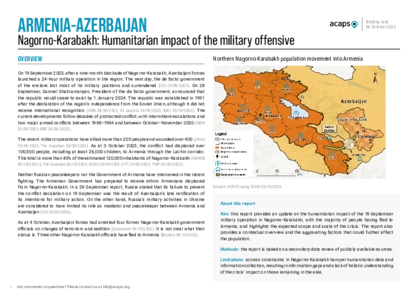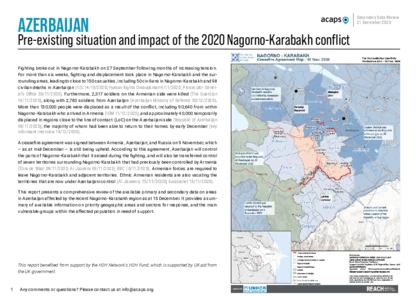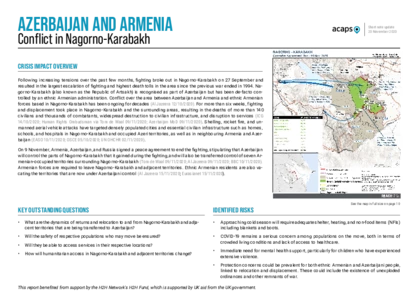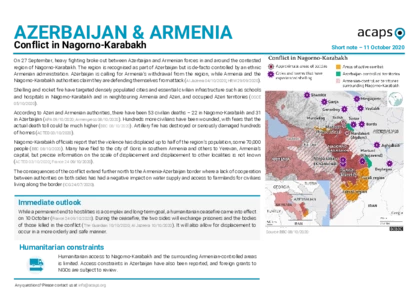Latest updates on country situation
26 September 2023
ARMENIA/AZERBAIJAN: After nine months of blockade, on 19 September, Azerbaijan launched a military campaign on the Armenian-controlled Nagorno-Karabakh region. Over 100,000 out of 120,000 ethnic Armenians have crossed into Armenia since the border opened on 24 September. The blockade created food, fuel, and medicine shortages, aggravated by military action leading to further shortages of electricity, water, and basic supplies. On 25 September, dozens of people were killed after a powerful explosion at a fuel storage depot. The blast happened as residents were lining up to refuel their cars to leave the region. A humanitarian aid station has been established at Kornidzor, near the Armenian border, where the flow of refugees is reaching a critical mass. In Goris, the closest large city near the border where refugees are gathering, shelter, food, and medicine needs are increasing. (Al Jazeera 26/09/2023,
HRW 23/09/2023,
ABC News 30/09/2023)
26 July 2023
On 11 July 2023, the Azeri authorities blocked the International Committee of the Red Cross (ICRC) from transporting goods and delivering services to Nagorno-Karabakh through the Lachin corridor. Besides the Russian peacekeeping mission, the ICRC had been the only organisation able to transport basic goods through the corridor after the Azerbaijani authorities blocked it on 12 December 2022, affecting the 120,000 majority ethnic Armenians living in Nagorno-Karabakh. Since then, the blockade has disrupted around 400 tons of daily deliveries of food and NFIs, resulting in shortages of medicine and other essential items, such as cooking oil, dairy products, bread, sugar, and salt. The blockade has also disrupted the passage of gas and electricity from Armenia through the corridor, leaving the region dependent on the limited capacity of the local hydropower plant for electricity. (OC Media 11/07/2023, OC Media 07/07/2023, HRW 21/12/2022)
Analysis products
on
Azerbaijan
06 October 2023
Armenia-Azerbaijan: humanitarian impact of the military offensive in Nagorno-Karabakh
DOCUMENT / PDF / 714 KB
This report provides an update on the humanitarian impact of the 19 September military operation in Nagorno-Karabakh, with the majority of people having fled to Armenia, and highlights the expected scope and scale of the crisis. The report also provides a contextual overview and the aggravating factors that could further affect the population.
20 January 2023
Armenia-Azerbaijan: Nagorno-Karabakh blockade
DOCUMENT / PDF / 532 KB
Since 12 December 2022, Azerbaijani ‘eco-activists’ have blocked the Lachin corridor which connects Nagorno-Karabakh with Armenia and is crucial for the transportation of essential goods to ethnic Armenian people residing in the region. It is affecting over 120,000 Armenian people, including 30,000 children, 20,000 older people, and about 9,000 people with disabilities living in Nagorno-Karabakh.
Attached resources
21 December 2020
Pre-existing situation and impact of the 2020 Nagorno-Karabakh conflict
DOCUMENT / PDF / 2 MB
This report presents a comprehensive review of the available primary and secondary data on areas in Azerbaijan affected by the recent Nagorno-Karabakh region as at 15 December. It provides a summary of available information on priority geographic areas and sectors for response, and the main vulnerable groups within the affected population in need of support.
20 November 2020
Armenia and Azerbaijan: Conflict in Nagorno-Karabakh
DOCUMENT / PDF / 3 MB
Conflict over the area between Azerbaijan and Armenia and ethnic Armenian forces based in Nagorno-Karabakh has been ongoing for decades. For more than six weeks, fighting and displacement took place in Nagorno-Karabakh and the surrounding areas, resulting in the deaths of more than 140 civilians and thousands of combatants, widespread destruction to civilian infrastructure, and disruption to services.
11 October 2020
Azerbaijan & Armenia: Conflict in Nagorno-Karabakh
DOCUMENT / PDF / 443 KB
On 27 September, heavy fighting broke out between Azerbaijan and Armenian forces in and around the contested region of Nagorno-Karabakh. The region is recognised as part of Azerbaijan but is de-facto controlled by an ethnic Armenian administration. Azerbaijan is calling for Armenia’s withdrawal from the region, while Armenia and the Nagorno-Karabakh authorities claim they are defending themselves from attack.






